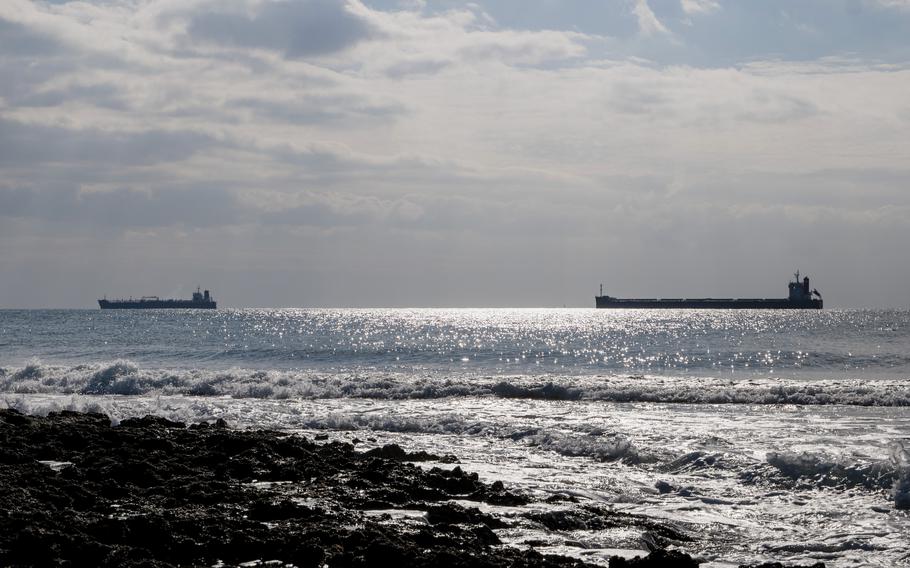
Oil and LNG tanker vessels offshore from the Fort de Bouc in the industrial and port area of Martigues, France, on Jan. 6, 2023. (Jeremy Suykur/Bloomberg)
Russia’s crude exports have yet to be curtailed by the latest U.S. sanctions to target its oil, with flows broadly stable. But while loading cargoes onto tankers is one thing, getting them off is another — and signs are emerging that the curbs are stalling the completion of shipments.
In the Pacific, only two of nine cargoes shipped from the Sakhalin Island oil and gas projects since the sanctions have discharged. Of the other seven, four are idling near the Russian port of Nakhodka, one has been between Japan and South Korea since Jan. 17 and another arrived Monday off its Chinese destination. The last has yet to reach a location where it too is likely to idle.
With a combined fleet of only 10 specialized tankers typically used to haul these grades, it won’t be long before shipments start to falter if the ships aren’t released. So far only one of the post-sanctions cargoes has been transferred to another vessel.
Key Pacific grade ESPO is continuing to move, with unsanctioned vessels being drafted in to replace those targeted by the U.S. last month. Only two of 27 cargoes loaded between Jan. 10 and Feb. 2 were put onto vessels sanctioned by Washington. Neither has yet attempted to offload its cargo, with one idling off Kozmino since it was loaded, vessel-tracking data compiled by Bloomberg show.
The first tanker to load a post-sanctions cargo from the Arctic port of Murmansk entered the Mediterranean on Sunday, heading for the Suez Canal. Shipping data suggests it’s heading for the west coast of India, where it should arrive in about two weeks’ time. New Delhi has said it won’t accept cargoes on sanctioned vessels after a deadline later this month.
If cargoes aren’t accepted at receiving terminals, floating storage of Russian oil will build up quickly. Already, one of the post-sanctions cargoes from Murmansk is on a ship signaling OPL Oman — a potential storage site — as its destination. Crude Shipments
A total of 29 tankers loaded 21.61 million barrels of Russian crude in the week to Feb. 2, vessel-tracking data and port-agent reports show. The volume was down from a revised 22.5 million barrels on 29 ships the previous week.
Daily crude flows in the seven days to Feb. 2 fell by about 130,000 barrels, or 4%, from the previous week to 3.09 million. Drops in flows from the country’s main Pacific port and the Black Sea was offset by an increase in shipments from Baltic terminals. Flows from the smaller Baltic port of Ust-Luga remain depressed compared with levels seen before mid-December.
Flows from the other two Pacific ports, which are tied to two separate projects off the coast of Sakhalin Island, remained stable. Crude continues to be loaded onto specialized tankers that were sanctioned in the latest measures adopted by the U.S. on Jan. 10, but long delays are emerging in delivering those cargoes.
Less volatile four-week average flows were little changed, edging higher by 20,000 barrels a day from the previous week’s revised number, to 3.02 million barrels a day. Two cargoes of Kazakhstan’s KEBCO crude were loaded during the week, one each from Novorossiysk and Ust-Luga.
Export value
A decline in the price of Russian crude added to the decrease in exports to leave the gross value of Moscow’s exports down by about $110 million to $1.39 billion in the week to Feb. 2.
Export values of Russian crudes were down week-on-week between $1.70 and $2.40 a barre. Delivered prices in India were also down by about $170, all according to numbers from Argus Media.
On a four-week average basis, income slipped to about $1.43 billion a week, from a revised $1.44 billion in the period to Jan. 26. Flows by Destination
Asia
Observed shipments to Russia’s Asian customers, including those showing no final destination, rose to 2.68 million barrels a day in the four weeks to Feb. 2, but remain about 15% below the average level seen during the most recent peak in October.
Europe and Turkey
Turkey is now the only short-haul market for shipments from Russia’s western ports, with flows in the 28 days to Feb. 2 falling for the first time in five weeks to 339,000 barrels a day.
NOTES
This story forms part of a weekly series tracking shipments of crude from Russian export terminals and the gross value of those flows. The next update will be on Tuesday, Feb. 11.
All figures exclude cargoes identified as Kazakhstan’s KEBCO grade. Those are shipments made by KazTransoil JSC that transit Russia for export through Novorossiysk and Ust-Luga and are not subject to European Union sanctions or a price cap. The Kazakh barrels are blended with crude of Russian origin to create a uniform export stream. Since Russia’s invasion of Ukraine, Kazakhstan has rebranded its cargoes to distinguish them from those shipped by Russian companies.
Vessel-tracking data are cross-checked against port agent reports as well as flows and ship movements reported by other information providers including Kpler and Vortexa Ltd.
If you are reading this story on the Bloomberg terminal, click for a link to a PDF file of four-week average flows from Russia to key destinations.
With assistance from Sherry Su.